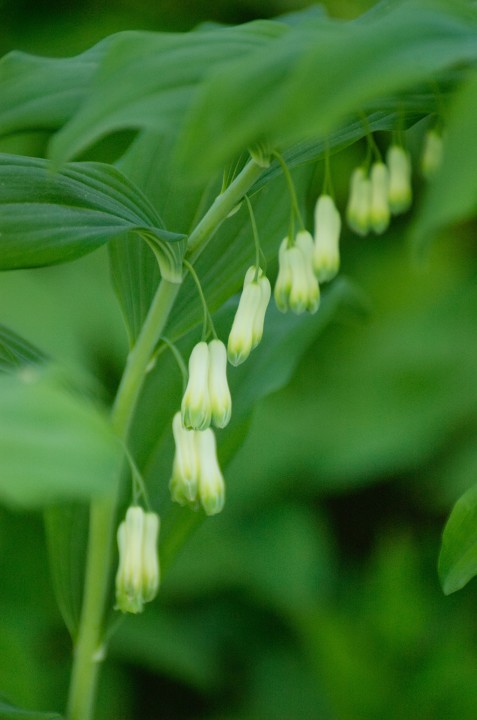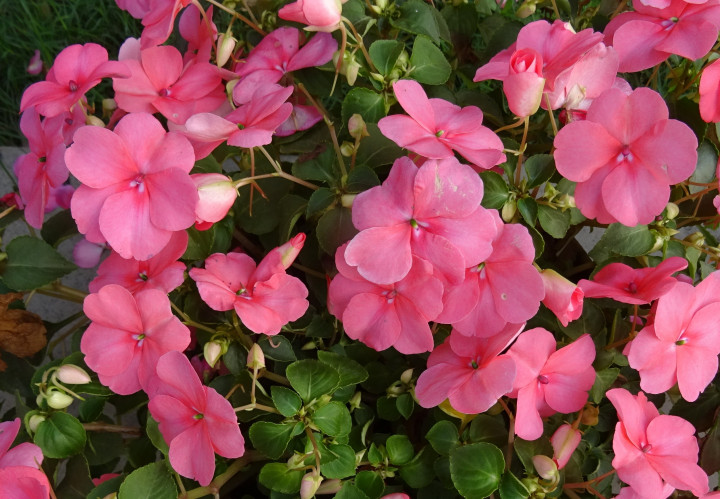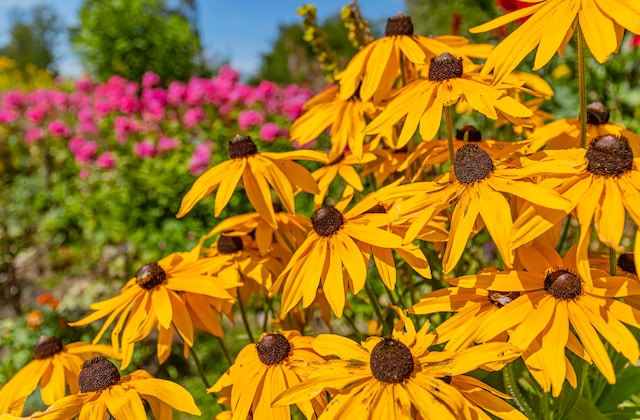Great Shade Plants for a Successful Shade Garden
If you think that you can’t grow anything in the shade, think again because there are plenty of great shade plants that you can add to your shade garden.
Don’t let the fact that your garden space is “sun” challenged keep you from having a great flower garden. In fact, there are plenty of options for shade plants that will thrive in areas like under trees or deep shade.

Shade Plants Suggestions
Here are some wonderful shade loving plants for you try in your shade garden.
- Impatiens
- Big Leaf Hydrangeas
- Ligularia
- Fernleaf Buckthorn
- Japanese Larch
- Solomon’s Seal
- Rudibekia Goldstrum
- Rudibekia Herbstonne
- Paul’s Glory Hosta
- Grape Vine
- Diablo Ninebark
Although these shade plants do best in partial or full shade, you may need to experiment with different varieties and locations to find the perfect spot for each of them.
It is also important to keep in mind that some of these plants prefer moist soil while others like it drier. For example, Fernleaf Buckthorn will do best when it is planted in moist soil, while the Solmon’s Seal plants prefer a dryer area. So make sure to research each plant before planting them in your garden.
In addition to these shade plants, don’t forget about adding foliage to your garden as well. Hostas and ferns are excellent choices for adding texture and color to your shade garden.
Hostas come in various sizes and colors, while ferns have lush greenery that can fill in any bare spots throughout your garden.
One more thing to consider is that some shade plants prefer filtered sunlight instead of deep shade. When choosing plants for these areas, look for ones that are drought tolerant such as ornamental grasses or even some cactus varieties.
Tips on Planting Shade Plants
When planting any type of plant, you want to make sure that you are giving it the proper care and attention to ensure that it grows and blooms beautifully. Here are some tips for planting shade plants:
- Make sure your soil is well drained, as wet soil can cause root rot in many types of plants.
- Feed your shade plant regularly with an organic fertilizer or compost.
- Water deeply and regularly to ensure the roots are getting enough moisture.
- Prune any dead or diseased growth, as this can spread to other plants in your garden.
- Plant in an area that will provide protection from the wind and harsh weather.
- Use mulch around your shade plants to help retain moisture and keep weeds down.
- Deadhead any spent flowers to encourage more blooms throughout the season.
Depending on your preferences, you may also want to consider adding some ornamental pots or planters to your garden. This is a great way to add even more texture and interest to your shade garden.
Shade Plants Design
When working on your shade garden design, be sure to mix textures and colors to make your garden more interesting for you as well as the visitors. You can also use larger plants to create a background for your design and then add smaller plants around them to fill in the spaces.
Also, don’t forget about adding some ground cover to your shade garden. Choose a shade-loving variety such as sweet woodruff or ajuga that will help keep weeds away and provide extra interest and texture to your shade garden.
Another thing you can to do spice up a shade garden is add a water feature. The sound of the bubbling water will be a cheerful addition to your shade garden. You can also use different shade plants to create ground cover or borders for your garden. This will help to define the different areas of your shade garden.
If you want to add some extra pizzazz to your shade garden, consider adding some colorful annuals. These can be planted in the summer months for a pop of color and they don’t require much care or maintenance.
Just make sure that you choose ones that are specifically designed for shade and keep in mind the amount of light that they will be receiving — too much or too little light can harm your plants.
Finally, you can use containers. Poor soil is a chronic problem with shade gardens, so planting in containers is a great way to overcome this problem. Place some containers under trees and other locations in your shade garden to provide a great focal point.
Shade gardens can be amazing additions to any landscape as long as they are designed properly and the proper plants are chosen. With the right plants, you can create a beautiful and lush shade garden for your home.

Shade Plants Care Tips
Shade loving plants need well-draining, organic soil that’s slightly acidic. Be sure to add compost and mulch around the root zone of these plants to keep the soil cool and moist.
When planting shade loving plants, try not to disturb their roots too much. Most of these plants don’t like to have their roots disturbed once they are planted so be sure to handle them with care.
Additionally, make sure that you water your shade garden regularly. Even though the plants will be in a shady area, they still need water to survive and thrive.
When it comes to fertilizing your shade plants, be sure to use fertilizer that’s specifically designed for these types of plants. This will ensure that they get all the nutrients they need to stay healthy and vibrant.
Pests and diseases can also be an issue with shade plants, especially if they aren’t getting enough light and water. Try to remove any diseased or damaged leaves as soon as possible so that the problem doesn’t spread.
You can easily spot these problems by inspecting the leaves and stems of your plants. If you notice any signs of pests or disease, make sure to take proper action as soon as possible to prevent it from spreading.
Finally, be sure to prune your plants regularly to keep them healthy and looking their best. Pruning will also help prevent overgrowth and encourage new blooms for the next season.
Plus, don’t forget about adding a layer of mulch to your shade garden. Mulch helps retain moisture, reduce weeds, and adds an extra layer of protection from the elements.
You can use rocks as well to add texture and interest to your shade garden. Rocks can be used in the same way as mulch, but they also provide a great backdrop for any plants that you add.

Frequently Asked Questions
Not only will these shade plants require the proper soil, care, and maintenance, but also keep in mind that some of them will do better with more sunlight than others.
Here are a few frequently asked questions about planting shade plants to help you get started.
Q: What garden plants grow best in the shade?
A: There are many types of shade plants that can be grown in the garden, such as ferns, hostas, impatiens, and begonias. These plants generally prefer indirect light but will still do well in an area with limited sun exposure.
Q: Which flowers grow well in shade?
A: When it comes to flowers, impatiens and begonias are two types of plants that do well in the shade. Other types of flowers that will also grow well in the shade include violets, pansies, and cyclamens.
Q: What are good shade plants for pots?
A: When choosing plants for pots, look for varieties that prefer indirect light. Some of the best shade-loving plants for containers include ferns, caladiums, and begonias. They are all relatively low-maintenance and will thrive in pots with minimal sunlight.
Q: What plants grow best in total shade?
A: Total shade is a difficult environment for plants to survive in, but some varieties such as Japanese forest grass, hostas, and ferns will still do well. Additionally, there are some flowering plants like impatiens and begonias that will also thrive in these conditions.
It’s important to research the specific types of plants you’re interested in before planting them in a shaded area to make sure they’ll get the right amount of light.
Q: What plants do well in part shade?
A: Part shade is a great option for many plants as it still provides some light but not too much. Some of the best options for part shade areas include hostas, astilbes, and heuchera. These all prefer indirect light and will do well in slightly shaded areas with filtered sun.
Q: What perennial shade plants will grow well under pine trees?
A: Pine trees are notorious for creating dry, acidic soil conditions which will make it difficult for most plants to survive.
However, some perennials such as ferns and hostas do well under pine trees because they prefer acidic soils. Additionally, there are some varieties of astilbes and heuchera that can tolerate these tough growing conditions.
It’s important to do some research before planting any perennials under pine trees so you can make sure they are properly suited for the soil conditions.
Q: What does shade tolerant mean?
A: It means that the plant is able to survive and thrive in areas with limited sunlight exposure. Shade tolerant plants don’t require direct sunlight and can handle living in an area with indirect lighting or even total shade.
These types of plants prefer filtered light but they are still able to adapt to their environment and grow without too much sunshine. Shade tolerant plants are great additions for shady areas of the garden and can add color and interest to any landscape.
Q: Can Bonsai plants grow in the shade?
A: While Bonsai plants do prefer direct light, they can still survive in an area with limited sunlight exposure. Most Bonsai trees will tolerate indirect light and filtered sun for a few hours each day.
If you are growing your Bonsai in the shade, make sure to monitor it closely and ensure that it’s getting enough water and nutrients.
Q: Why do plants in a shade tend to wither?
A: Plants can wither in the shade due to a lack of light, inadequate water or nutrient levels, disease, pests, or environmental stress. If your shade plants are wilting, make sure to inspect them closely and look for signs of any issues that could be causing the problem.
If nothing appears to be wrong with the plant itself then it’s possible that the environment may be too shaded or the soil isn’t providing enough nutrients. In this case, you may need to adjust the amount of shade and add fertilizer to ensure your plants are getting all they need.
Once you address any potential issues with your shade plants, they should start to look better and will thrive once again.
Q: Would grow lights help an outdoor garden with very less direct sunlight?
A: Yes, grow lights can be used to supplement the sunlight in an outdoor garden with limited exposure. These lights provide additional light for photosynthesis and can help your plants flourish even if they don’t receive direct sunlight.
Grow lights should be used cautiously as too much light may damage delicate plants and cause them to wither or die. It’s important to monitor your plants closely and adjust the amount of light they receive as needed.
Q: How do I get indirect sunlight or partial sun partial shade for my potted plants outside?
A: You can provide indirect sunlight or partial sun/partial shade for your outdoor containers by placing them in an area with limited direct exposure.
Porches, balconies, and other semi-shaded areas are great spots to place potted plants as they will still get some light but won’t be directly hit by the sun’s rays.
Additionally, you can use a sun shade or other type of cover to filter the light and provide more protection from direct sunlight. This will help ensure that your plants get all the light they need without becoming scorched by too much exposure.
Q: What features distinguish a plant adapted for full sunlight from one adapted for partial or full shade?
A: Plants that prefer full sunlight tend to have larger and more colorful flowers, while shade-loving plants usually have smaller or less vibrant blooms.
Additionally, sun-loving plants tend to be more drought tolerant and require less water than those that prefer partial or full shade.
The leaves of plants adapted for full sun will also be thicker and darker in color. Shade-adapted plants, on the other hand, have lighter colored and thinner leaves that are better suited for surviving in low-light conditions.
Finally, sun-loving plants usually require more fertilizer compared to shade-loving varieties because they need extra nutrients to thrive in hot, sunny climates. Shade-adapted plants tend to be more tolerant of nutrient deficiencies and will still perform well without too much fertilizer.
Q: Are there any plants that do well in both full sun and partial shade?
A: Yes, certain types of plants can tolerate both full sun and partial shade. For example, some varieties of ferns such as Japanese forest grass are able to thrive in either setting.
Similarly, hostas and heuchera are also adaptable to both sun and shade. Astilbes are another great option as they can tolerate a variety of light conditions.
Q: Does the amount of sunlight affect the height of a plant?
A: Yes, the amount of sunlight a plant receives will affect its growth and height. Plants that are exposed to full sun will usually grow taller than those in partial or full shade.
Additionally, if a plant doesn’t receive enough sunlight it can become stunted or fail to reach its full potential size. On the other hand, too much light can cause plants to become spindly or leggy due to a lack of adequate nutrition and water.
Your Takeaway
Shade gardens can be a source of great enjoyments for home gardeners. Take some time to learn more about the varied shade plants that are available to adorn your flower garden.
Don’t let the shade get you down, make your shade garden shine with some of these great shade loving flowers and shrubs.
We hope the FAQs above have cleared up any questions that you had about shade gardens and plants. For more information about shade plants for your garden, visit the Backyard Farmer website.